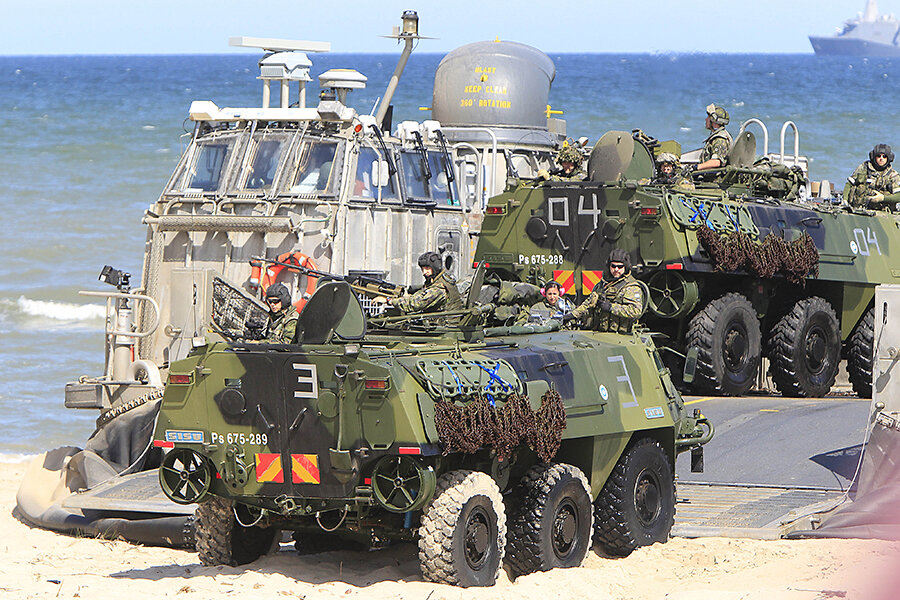Cold war 2.0? Russia, NATO edge toward high-risk military standoff
Loading...
| Moscow
For more than a year, antagonistic rhetoric and deeds have ticked upward as the West seeks to restrain and punish Russia for its actions in Ukraine.
Moscow and NATO have broken off ties, and both sides have staged an escalating series of war games near each other's borders. Experts have been pointing to the growing risk of accident or miscalculation as Russian and NATO ships and planes are increasingly thrown into unscripted encounters in international territory.
This week the temperature of the rhetoric jumped, with both sides threatening deeds that bring them closer to permanent force deployments on their borders – and recreate the sort of standoff that scarred two generations during the 40-year-long cold war. And the hard-won agreements that once reined in the strategic nuclear arms race between the US and the USSR are coming under strain.
"This confrontation so far has been mostly just for show, with each side trying to demonstrate to its own people and the other guy that they are determined not to back down. Leaders on both sides are sure they can control it," and roll it back whenever they decide to, says Viktor Kremeniuk, deputy director of the official Institute of USA-Canada Studies in Moscow and author of a new book, "Lessons from the Cold War."
"But it is starting to take on a life of its own, and there is a growing danger that it can become unmanageable," he says.
'Not in a state of peace'
Pentagon officials did not deny reports that the US is mulling an unprecedented plan to "pre-position" heavy weaponry in east European countries that border Russia, which the Russians claim would violate a post-cold war understanding that those former Soviet-controlled areas would remain demilitarized.
In a meeting with Finnish President Sauli Niinistö in Moscow Tuesday, Russian President Vladimir Putin warned that Russia would retaliate. "If someone threatens our territories, it means that we will have to aim our armed forces accordingly at the territories from where the threat is coming. How else could it be? It is NATO that approaching our borders, it’s not like we are moving anywhere," he said.
That led a nervous Mr. Niinistö to remark that "Europe is not in a state of peace."
At a military exhibition outside Moscow on Wednesday, Mr. Putin ramped up the rhetoric by declaring that Russia will add 40 new intercontinental ballistic missiles to its strategic arsenal this year. That was received in the West as dangerous nuclear saber-rattling from Moscow, though arms control experts point out that both sides are modernizing their strategic nuclear arsenals. Putin was just reporting this year's quota in a longstanding Russian program to replace older ICBMs with new ones that could resist the planned NATO anti-missile shield for Europe.
"It's my impression that strategic arms remains the one area where things are still pretty much under control," says Mr. Kremeniuk. "We have treaties that govern numbers, and they are still actively verified by both sides."
The nuclear problem
The situation is far more threatening when it comes to medium- and short-range nuclear missiles, experts say. Russia has long warned that it might counter the projected missile-defense system by stationing nuclear-capable short-range Iskander-M missiles in Russia's western enclave of Kaliningrad, from where they could hit Warsaw, Berlin, and Copenhagen.
Washington already accuses Moscow of violating the Intermediate Nuclear Forces (INF) accord, which ended decades of nuclear threat in Europe by abolishing an entire class of medium-range missiles. And the US has also floated the idea of once again deploying nuclear-armed missiles on European territory. All together, it could mean the INF is headed for the scrap heap.
"We are seeing a very serious turn," says Alexander Golts, an independent Russian military expert. "We had a stable status quo, based mainly on treaties and mutual trust. When you transition from that to a situation where security is based on mutual military deterrence, that's a very different world. But that's where we are headed, quite rapidly."
If the INF treaty should be canceled, Europe could return to the nuclear standoff of the mid-1980s, in which virtually all European capitals faced less than 8 minutes' warning from Soviet SS-20 and US Pershing-II medium range nuclear missiles.
"It's in no one's interests to scrap this treaty, but it's clearly become a target for people on both sides who think words must be backed up by resolute actions," says Kremeniuk.
"We have all these people who never left the cold war mentality behind, who seem to think their moment has arrived. The logic of escalating rhetoric, followed by confirming actions, is already in full swing. Unless leaders on both sides call a halt to this deterioration, the basic pillars of European security – which people worked so hard to put in place – could get knocked away."






